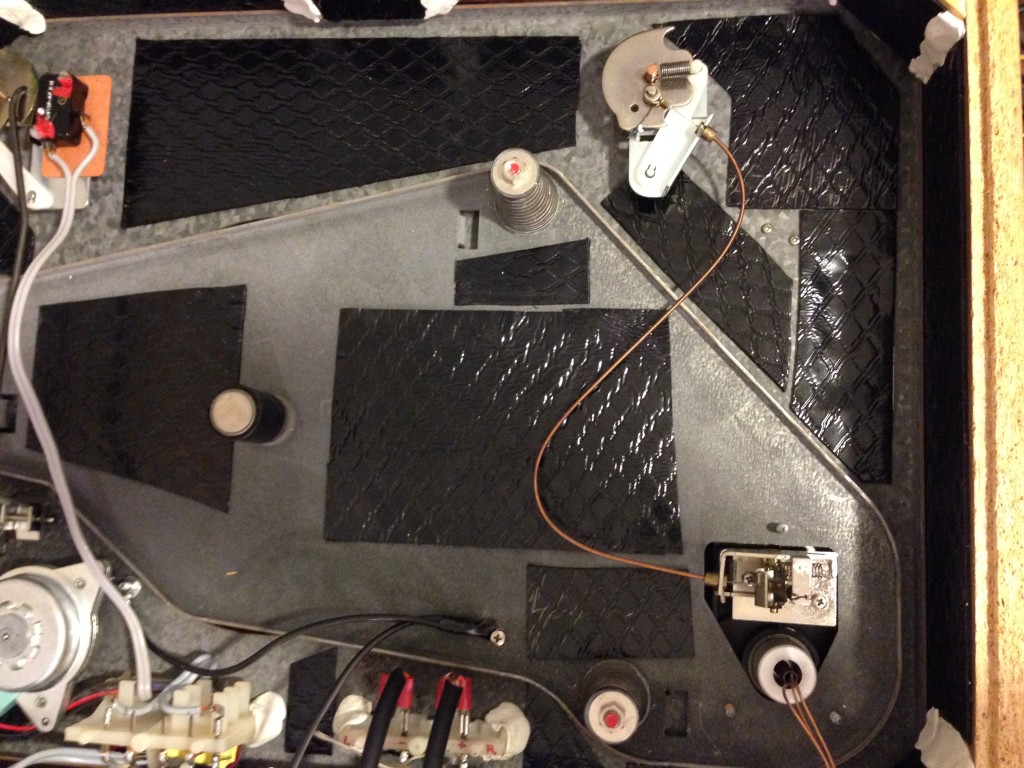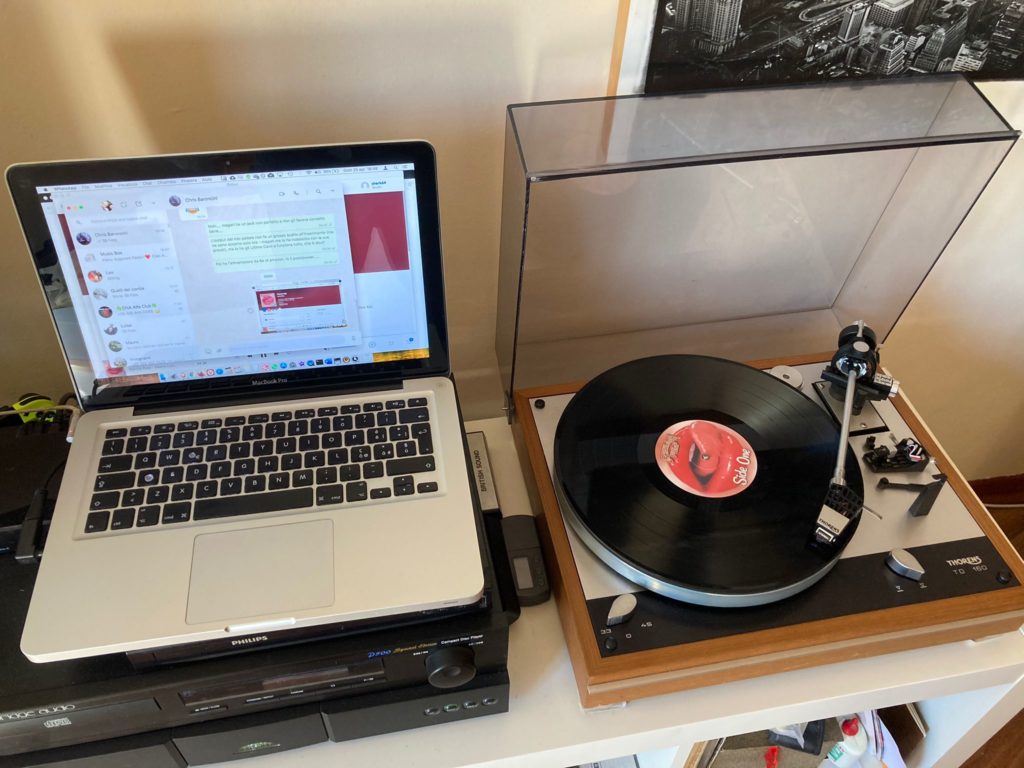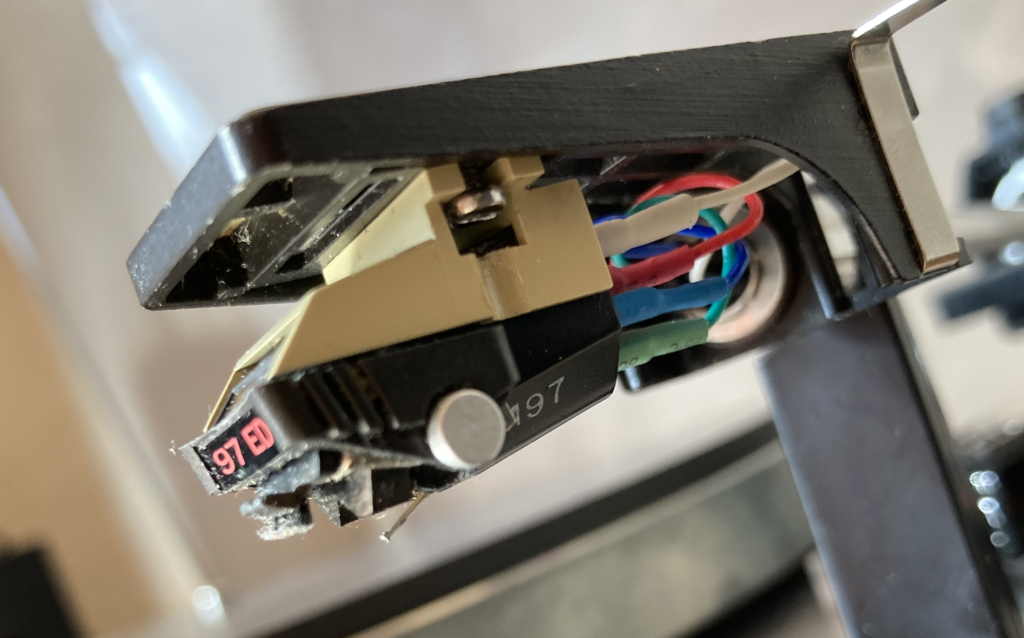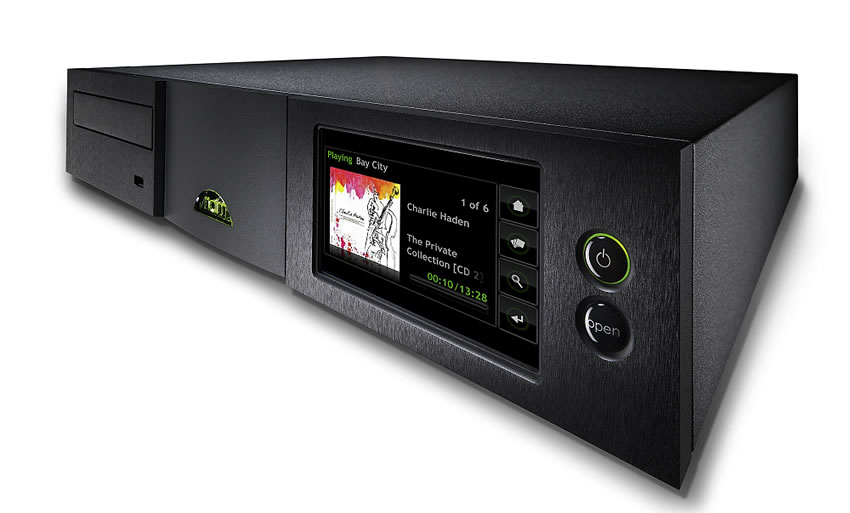Every now and then I vent on this blog the hifi quandaries that arise after certain reflections. Obviously I choose the exaggerated word quandary to be ironic about the problems that often attack the minds of hifi enthusiasts, known as audiophiles. How can these really be existential problems? Much more should we worry about and turn into a real quandary. So let me be self-ironic and get to the point, because for someone who has a blog titled “I still play vinyl” and shares tips on how to best adjust Thorens turntables, this could be a real revolution, something total that shakes the foundations. On the plus side, questioning oneself and one’s ability to change ideas and contradict oneself is sometimes a good thing…
I need to make an additional premise. The quandary in question stems from the fact that yours truly can’t keep possession of things he doesn’t use. I’m talking specifically about electronic and otherwise technological devices. If I buy them it is because I need them. If I don’t need them I don’t buy them. If I bought them and I don’t need them anymore, I don’t keep them as a souvenir. I resell them if possible. In short, I don’t have the nature of a collector. For example, of every music album I have, I own only one copy, only one edition. If I already have, say, the first release of an LP, I wouldn’t dream of buying a special reissue. If I had reason to believe it was really better than the one I have, I consider whether I should buy it. Then I resell the other one. At the most, I have one LP and one CD edition: once it was convenient to use the CD in the car, but today it is anachronistic and anyway I consider it a waste of money since I can save the audio of the LPs on files to play in the car or anyway on the move. I have duplicate LP and CD copies out of curiosity to make sonic comparisons. Nothing else.
The point is: I still play Vinyl, I do…. but….. rarely, increasingly rarely. Moreover, we must admit that the quality of the final listening does not depend on the medium (LP or CD) but on the quality of the original recording and its mastering. The same album can have a bad LP edition and a very good CD edition. The ideal would be to find out which of the two is the best and buy that one.

The vibrations triggered by the motor and the sound itself that comes out of the speakers are among the main enemies to fight in an analog system but also digital (only for optical discs and to a lesser extent)
But the first dilemma is right there: the CD might cost, maybe used, a few euros. A vinyl LP when it’s good is just under 20 euros. Some editions are well over that. What is the point of spending double or triple for a vinyl LP when the CD could sound just as good? I’ve been asking myself this question for a long time and in the dark periods, when I certainly couldn’t afford to buy LPs, I rarely “bent” to buy the CD, more often I just gave up.
But what’s the point? Well, for people my age, the vinyl record was the norm in my youth and it is still a pleasure to use it today. The sound quality can be remarkable, but it’s no joke to get there. Getting there is also fun for some, a pastime. But it’s a major time and money commitment. When, as happened to me, you lose your job, certain things take a back seat: the music would be the same, the listening quality would still be high, so you buy the CD and you don’t throw a tantrum! And what about the various streaming services at 10 euros a month? If adding up the albums purchased in a year you get close to 120 euros, what’s the point of continuing rather than subscribing to a service that offers almost all the music available? If I resold my vinyl collection, turntable and cartridges I could buy for the same amount of money an excellent streamer or network player and enjoy high fidelity music without problems. What to do?
There are those who love to own the object, the physical medium, so they would never do without a CD or LP and I understand them. Playing a file or playing an LP is just another thing. But the goal should be to be able to enjoy the music we like at a level of sound quality definable as high fidelity (and maybe spending as little as possible). There’s no denying that digital streaming has made great strides and it’s not easy to say which sounds better, CD or vinyl record with the same quality of the original mastering. The compressed formats (“lossy”) today enjoy powerful algorithms that allow them to sound almost hifi even at low sampling rates.
To be honest, “high definition” digital formats, i.e., higher than CDs, which is defined as the low resolution “uncompressed” standard, are not always that much better for listening. The problem is that sometimes remastering at high resolution tracks that originally did not have that same resolution results in a file of even lower audio quality. But maybe the main reason is the so called “loudness war”: nowadays people tend to master by compressing the signal a lot and turning up the volume, thus obtaining a very direct sound that at first impresses but lacks dynamics and those who have a trained ear and taste immediately realize that the quality is poor.
That’s probably why you read that even experts with trained ears often don’t find much difference between a 44.1 kHz 16-bit file and a 192 kHz 32-bit file! Unless it’s the original master file (from the first recording – then it would be like being there!). In addition to trained ears, you need a system that costs some money! A very good hifi system that is equipped with a digital system capable of reading the CD 16/44.1 standard properly could be much more than enough to enjoy music at the top of the audio quality, without bothering to search or download high resolution files and converters capable of handling the reproduction.
As far as I’m concerned, I’d never bothered with testing before. I had only used streaming from the iPhone to the Apple TV 3, which still has an optical digital output, connected to the DAC. Unfortunately, the Apple TV reduces everything to 48kHz and 16-bit, and I had only tried Spotify and Apple Music, which use compressed formats. Nothing striking but good for casual listening.
But as a source I would have my Macbook with optical digital output to connect to the DAC. Actually I did not dare to try, I was afraid of the result… Well, when I finally decided to give it a try, the VOX player playback of tracks extracted from CDs with iTunes didn’t particularly excite me. It might have been for two reasons: 1- the iTunes extraction might not be that great; the toslink optical cable is not the best for transmitting digital music data. The original CD (via the same DAC) sounded quite better. On the other hand, the test with a high-res streaming service (Qobuz) was superior to the CD, quite obviously (a sign that the album, of audiophile quality, did not suffer from the loudness war).

In my system, high-resolution streaming didn’t really stand out. But that’s because I’ve compared recently remastered tracks of old hits that sound significantly better in analog. More modern, quality productions (not compressed a la loudness war) are definitely superior, but how much of that is in your favorite music?
But let’s get to the details of the tests I was able to perform.
Analog system: Shure M97ED Era IV (nude Nagaoka elliptic stylus) > Thorens TD 160 with stock TP16 tonearm > Van Damme low capacitance phono cables with Neutrik connectors and ground connector > Pre Fono Lehmann Black Cube Statement > TNT-U-Byte signal cable.
Digital system: Qubuz Player Premium HiFi > Macbook Pro > standard toslink optical cable > Pro-Jext DacBox E converter > Monster Cable Interlink 300 signal cables (from the 90s)
All amplified by a Naim Nait 5i > TNT-Star speaker cables > TDL Studio 0.5 loudspeakers (transmission lines with bass that drops to 30 Hz, audible in my 6×7 m room of irregular floor plan = if they have recorded the bass, I can hear it!)
Note: it must be admitted that the analog system is of superior quality, in particular a more powerful DAC would have made the game less uneven. But let’s also remember that a DAC costing twice as much as mine would only improve nuances (with digital it’s like that).
The first test I performed with the Prestige’s audiophile CD, Diana Krall, Love Scenes, mentioned above. It is superbly recorded and Diana Krall seems to be a guest in my home, singing between the two speakers. I had “ripped” this disc with iTunes and it is saved on the internal SSD hard drive. My Cambridge Audio D500SE CD is connected to the same DAC but with a coaxial cable. The player I use on the Mac is VOX. The ripped file sounded significantly worse than the CD, a really flat presentation. In contrast, streaming the same disc on Qobuz was very similar to the original CD, which gave the feeling of being a bit better. But on Quobuz the 24-bit, 96 kHz Hi-Res version is available. While I couldn’t take full advantage of it via the optical connection, selecting the same resolution on the Mac’s output opened up the sound considerably. Exciting!
So I tried a few other tracks that I had available vinyl records of. One of my ” fixation” is the intro to Rosanna, by Toto, on their 4th album. Jeff Porcaro’s drums are sublime and beautifully recorded. The vinyl record makes it palpable, beautiful. The Qobuz Hi-Res stream doesn’t disappoint at all, but something about the vinyl draws me in more. I blamed it on the higher quality of the analog system and thus a bit of an uneven struggle. Using as a player a plugin like Audinirvana or Amarra (the most popular on Mac) things get better: they provide a system optimization for audio playback, bypassing the standards of the operating system. But even so, in my system, I repeat, a bit more advanced in analog, if the original recording is not well mastered and free from exaggerated compression, you can still perceive a better quality from the vinyl record.
I have several Pink Floyd albums: The Wall and The Dark Side of the Moon are UK editions of the time. They are not recordings known for their immense quality but knowing them well I could make a good comparison. On Qobuz there are remasters from 2011 or newer. Compared on my system they lose bitterly against the analog section. There is no comparison. I almost have to say that the Hi-Res tracks on Quobuz really suck. The remastering has been done very poorly. Most likely to resell the old hits in new formats remastered with modern technology (and very questionable methods). There is no comparison: the vinyls are alive and pulsating, the Hi-Res tracks are flat and dull…
To remove my doubt I switched to jazz and unleashed a Prestige edition of the great John Coltrane: Ballads, a rather expensive 180g disc and certainly an “audiophile” record. There are three versions of this album on Qobuz, one at CD quality from a few years ago, two Hi-Res remasters from 2007 and 2013. They lose dismally to my audiophile vinyl edition, embarrassingly so. The unremastered, CD-quality (= not hi-res) track is much better sounding and approaches the performance of my 180g disc.

The old vinyl technology should be outdated and pale before the power of high resolution digital! Unfortunately, many digital recordings are shabby, made with heavy dynamics compression when there would be much more dynamics available than in vinyl records! So a little heroine of the old days, the Shure M97 Era IV, still “rocks” among the young people of today who think they can impress with the loudness war …
Conclusion: The key is the original recording and even more the (re)mastering. I have some badly mastered vinyl records that I didn’t even bother to try, I was sure they would lose badly against Qobuz Hi-Res editions, as even the MP3s attached to vinyl albums sound better! An ironic note: the Qobuz logo is a vinyl record…
In short, imagine a digital system reading music data from an SSD hard disk: no moving parts, no rotation, no reading errors, so no need for data interpolation. Every single digital sample of the audio signal is collected and reproduced accurately. The only issues would be those of the quality of the digital-to-analog conversion section (both the chip used and the power supply and output section). If the source, the file, is okay, the original recording is of quality (and so is its final mastering), the excellent result is guaranteed and immediate. Otherwise, if they are high resolution remasters made to keep selling old hits and especially with the compression that is fashionable today, the result is pathetic, whether streaming via internet or on CD or vinyl. Having said that, we’re talking about audio quality that we can be happy with, but when compared to something else on a system of a certain level, the knots come to the boil. Compressed formats can also be a good compromise. It depends on what you want and the system you use.
Remember that to get serious results with analog systems, the turntable must be placed on a perfectly horizontal plane, rigid and isolated from vibration, the cartridge properly aligned, with the right reading pressure and anti-skating bias. A digital system is easier to set up (aside from app and drivers configurations and network disks). It is also clear that the analog system has its inherent limitations, starting with the equalization of low frequencies, which are recorded with greatly reduced amplitudes in order to engrave them in the walls of the grooves that have limited thickness. Then the phono preamplifier re-equalizes everything properly and it is also surprising that with all these obstacles to proper reproduction the result can be so excellent if you accept background noise and clicks.
If you want to set up a minimal digital system, a simple Cocktail Audio “streamer” (which is also a CD player and integrated amplifier) and two quality speakers might be all you need to start your journey into high fidelity: the built-in CD player allows you to extract audio files the first time you listen to a disc and save them to the internal hard disk. Next time you will play the file directly, without the errors caused by reading the spinning optical disc playback will be even better. For the rest, we can connect it to our favorite streaming service and access all the music we want, albeit in compressed quality on Spotify or Apple, but also at CD level (Deezer and Amazon) and beyond on Qobuz or Tidal (at double the cost, though). In my experience, Qobuz at CD quality sounds better than Deezer. We’ll see when later this year Spotify HiFi will also provide CD quality streaming. But again: today the available algorithms allow even the compressed files of Spotify and Apple to play decently on a serious home hifi system, but if the system is really good the difference with the high resolution – if real – is well perceivable. On the go, with earbuds and smartphone I don’t see why bother with high resolution, modern compressed audio is more than fine. Even some well recorded YouTube videos sound decently good! And mind you, some have shown, waveforms in hand, that the similarity between that recorded from a vinyl record and that of Youtube is quite disconcerting!

You don’t need a dream streamer like the Naim HDX (unattainable for me) to comfortably and more easily enjoy a really good audio result
So, why would I do that?
I don’t know. Every time I put on a vinyl record after days of audio from cell phone, TV, radio, etc., I’m left speechless like it’s the first time. This doesn’t happen – not to these levels – when I put on a CD, but it has to be said that my analog section is far superior to my digital one. What if I had a great converter? Already with my very inexpensive Project DacBox E, although the files read by my Macbook lose the comparison with CD (mind that the read mechanism should be a bit “fatigued”), the streaming is at least comparable to CD and superior if it comes to serious high resolution. This should have put my original preference for analog audio to the test. But it didn’t. and I think it’s due to the fact that record companies and artists themselves are not making the best use of what modern digital technology has to offer, bowing to the loudness war specifications.
From a rational point of view, the problems of digital audio are far less than those of the analog audio. From the tip of the needle to the output of the phono preamplifier it is a continuous obstacle jump. When it ends well, the satisfaction is great, but is it worth it? Not economically, not even in terms of time, nor in terms of space occupied, if you like. Theoretically, modern digital is intrinsically superior to analog. But there are realities such as direct-to-disc recordings that, as at Sheffield Labs, acquire the audio with a very good stereo microphone used in the same way as a pair of human ears and cut the disc directly from the analog tape thus recorded. No mixing, no mastering, just the music as it was played, no molds whose copies are distributed to producers. It seems that the results are nothing short of exceptional, nothing to do with digital (at least at the time of the review: 2009). They even use the analog master to produce the CD versions! In short, there is no such thing as better support per se, the original recording is the thing (a better or worse one).
But as Lucio Cadeddu of TNT-Audio put it, a radiator heats very well without problems, but what about a fireplace? I can’t find a better analogy! To warm your apartment, you just turn on the system and in a few minutes you get what you need. With the fireplace it takes work, getting the wood, arranging it well, lighting the fire (not an immediate task) and keeping it alive. And then the maintenance: clean it, dispose of the ashes, etc.. A lot of work, and the result is often not as efficient as well-proportioned radiators. That’s right, the CD does its dirty work and (today) does it very well too. Even better if you are dealing with uncompressed files so the reading is almost error-free. Keeping the records clean, brushing them every time before playing them, aligning the cartridge well, adjusting the tonearm, cleaning the needle and replacing it when necessary, is a rather complicated ritual but the result can be very satisfying and under certain conditions even superior to digital. Sure, you turn on the streamer, select an album, the sound starts and off you go. Done! Almost no maintenance, very similar if not better results. But it’s a different feeling. Or isn’t it…?
